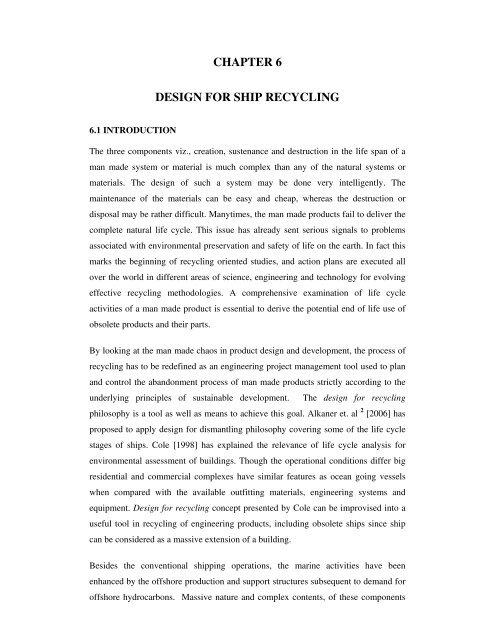Development of Best Practices for Ship Recycling Processes
Development of Best Practices for Ship Recycling Processes
Development of Best Practices for Ship Recycling Processes
Create successful ePaper yourself
Turn your PDF publications into a flip-book with our unique Google optimized e-Paper software.
6.1 INTRODUCTION<br />
CHAPTER 6<br />
DESIGN FOR SHIP RECYCLING<br />
The three components viz., creation, sustenance and destruction in the life span <strong>of</strong> a<br />
man made system or material is much complex than any <strong>of</strong> the natural systems or<br />
materials. The design <strong>of</strong> such a system may be done very intelligently. The<br />
maintenance <strong>of</strong> the materials can be easy and cheap, whereas the destruction or<br />
disposal may be rather difficult. Manytimes, the man made products fail to deliver the<br />
complete natural life cycle. This issue has already sent serious signals to problems<br />
associated with environmental preservation and safety <strong>of</strong> life on the earth. In fact this<br />
marks the beginning <strong>of</strong> recycling oriented studies, and action plans are executed all<br />
over the world in different areas <strong>of</strong> science, engineering and technology <strong>for</strong> evolving<br />
effective recycling methodologies. A comprehensive examination <strong>of</strong> life cycle<br />
activities <strong>of</strong> a man made product is essential to derive the potential end <strong>of</strong> life use <strong>of</strong><br />
obsolete products and their parts.<br />
By looking at the man made chaos in product design and development, the process <strong>of</strong><br />
recycling has to be redefined as an engineering project management tool used to plan<br />
and control the abandonment process <strong>of</strong> man made products strictly according to the<br />
underlying principles <strong>of</strong> sustainable development. The design <strong>for</strong> recycling<br />
philosophy is a tool as well as means to achieve this goal. Alkaner et. al 2 [2006] has<br />
proposed to apply design <strong>for</strong> dismantling philosophy covering some <strong>of</strong> the life cycle<br />
stages <strong>of</strong> ships. Cole [1998] has explained the relevance <strong>of</strong> life cycle analysis <strong>for</strong><br />
environmental assessment <strong>of</strong> buildings. Though the operational conditions differ big<br />
residential and commercial complexes have similar features as ocean going vessels<br />
when compared with the available outfitting materials, engineering systems and<br />
equipment. Design <strong>for</strong> recycling concept presented by Cole can be improvised into a<br />
useful tool in recycling <strong>of</strong> engineering products, including obsolete ships since ship<br />
can be considered as a massive extension <strong>of</strong> a building.<br />
Besides the conventional shipping operations, the marine activities have been<br />
enhanced by the <strong>of</strong>fshore production and support structures subsequent to demand <strong>for</strong><br />
<strong>of</strong>fshore hydrocarbons. Massive nature and complex contents, <strong>of</strong> these components
















